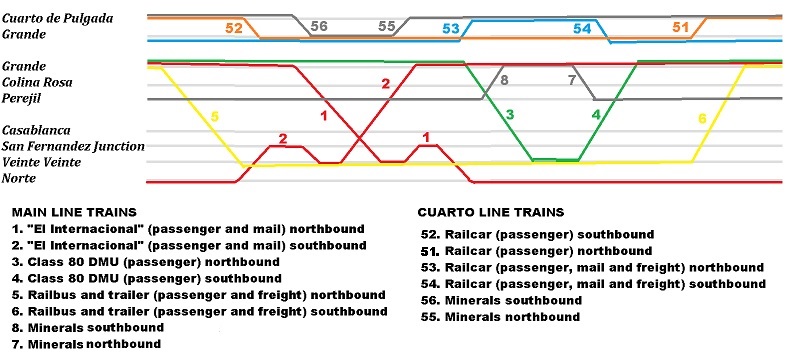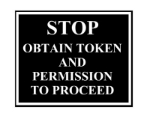Derrotado is will lose the through train to/from Grande for the next operating session. The low level micro layout can still be run independently using a combination of conventional and puppet rod powered trains. As the branch terminus has lost its turntable double ended railcars and back to back singles will be the order of the day for passenger trains. Freight will be handled by a dummy loco, propelling towards the terminus, because this gives much better slow running when shunting.
The main line mineral trains will be rerouted via Perejil, in other words they will start and finish on the hidden siding behind Colina Rosa. This is why the through train from Derrotado has been withdrawn.
The rerouting of the minerals means the international train can be run via San Fernandez, giving loco hauled passenger trains across the full length of the main line. The southbound train will start from San Fernandez hidden siding, reverse at the junction to back into Veinte Veinte for a station stop.
The northbound international will pass the southbound between Casablanca and San Fernandez. It will run into Veinte Veinte to make its station stop then back out to the junction before heading into the hidden siding.
The mineral trains on the Cuarto line will be steam hauled. They, along with the main line minerals, and both international passenger workings, will mean there are a total of six steam hauled trains during the day.
The morning class 80 set’s trip from Grande to San Fernandez and back will not be needed because “El Internacional” will provide trains 1 and 2, the DMU will still run as the afternoon trains, 3 and 4, though and the late evening/early morning railbus will also still be required. Between them these provide three daily passenger trains in each direction, plus the minerals between Grande and Perejil.
Railcar services on the Cuarto line will be the same as they were for the March session, giving two passenger trains in each direction, plus the minerals.
This (in)frequency of trains may seem lacking to people used to an hourly or half hourly interval service but you should bear in mind that the FCPyF serves a remote area high in the Andes so two or three trains a day is actually pretty generous. There are places where two or three trains a week is seen as extravagance! Read on to see what takes place at Grande and you’ll probably not wish for more.

A new pathing diagram is required to reflect the main line service changes. Shown above with the trains listed as numbered pairs, 1 and 2 alternate daily the other pairs end up back at their starting points. The diagram is repeated below, this time with the trains listed sequentially for each line.

In this form it is of use to the operators at Cuarto de Pulgada and San Fernandez. The pathing diagram is repeated for a third time, here is has the trains from both lines listed sequentially as they arrive and depart at Grande.

What is still not shown is the local shunting required to keep the run round loop, turntable access and station platform clear as and when required… This is where the fun starts, I’ll need to give it a test run before the timetable can be confirmed as workable.
The DMU will need to shunt clear of the carriage shed while train 1’s loco collects its stock then return to the shed siding afterwards. The railcar from train 52 needs to be held on the loop during this time then shunt to the loco shed to occupy the berth vacated by train 1’s loco. Train 2 needs to run round on arrival and shunt to the end of track while the railcar to work train 53 shunts from the loco shed. Train 2’s loco can then shunt to the loco shed and the DMU is released from the carriage shed siding to work train 3.The stock from train 2 will then need shunting, using the station pilot, to the carriage shed siding before train 8 arrives. The railcar from train 54 should hold at the end of track while train 4 arrives and the DMU shunts to the carriage shed siding. It can shunt to the loco shed when a berth is available after train 51 has departed.
Phew!Any volunteers for the job of stationmaster at Grande?
Perhaps the best position for a trainee operator would be San Fernandez. The loco and stock workings here do not need to run round as they back in or out between the junction and Veinte Veinte, the DMU is also a straight in and out working. The only shunting within the station is turning the railcar and trailer then parking it in the bay platform. When not occupied with his own trains the operator at San Fernandez is ideally located to watch the activity on the other side of the aisle at Grande.
Second step on the ladder would be Cuarto de Pulgada. The mineral train needs to run round on its downhill trip but it’s just a matter of backing onto the mine spur when the empties return from Grande. Some of the railcars used on the Cuarto line need to use the turntable between arrival and departure. When not on his feet working at Cuarto the operator here can sit down to watch trains passing through Colina Rosa on the main line or operate Derrotado, a chance to experiment with puppet rods or just run the railcars in and out at random.
The May operating session will be held mid month, exact date yet to be arranged. Guests are welcome by prior arrangement and it is a lot easier operating the layout with assistance than doing it by myself.
oscalemodeller@aol.co.uk
The FCPyF is in Wheelock, served by D&G Buses 37 (Crewe/Sandbach/Winsford/Northwich) and 38 (Crewe/Sandbach/Congleton/Macclesfield), a few minutes drive from junction 17 on the M6.


You must be logged in to post a comment.